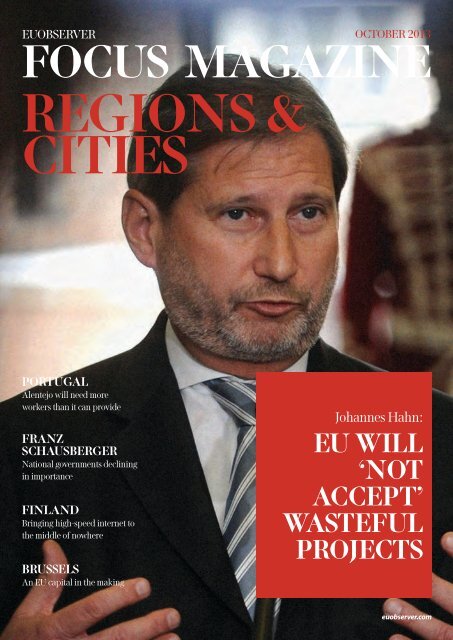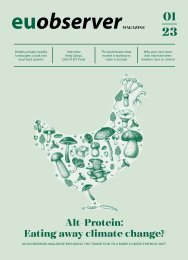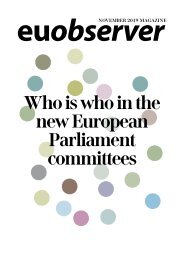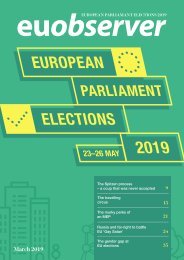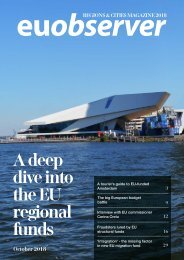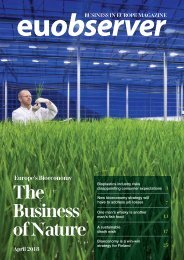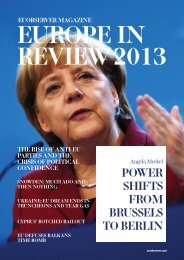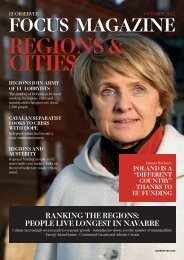Regions & Cities 2013: Cohesion Policy and Regional Aid
The 2013 edition of EUobserver's Regions & Cities magazine looks at cohesion spending and successes and failures of EU regional aid.
The 2013 edition of EUobserver's Regions & Cities magazine looks at cohesion spending and successes and failures of EU regional aid.
You also want an ePaper? Increase the reach of your titles
YUMPU automatically turns print PDFs into web optimized ePapers that Google loves.
EUOBSERVER<br />
OCTOBER <strong>2013</strong><br />
FOCUS MAGAZINE<br />
REGIONS &<br />
CITIES<br />
PORTUGAL<br />
Alentejo will need more<br />
workers than it can provide<br />
FRANZ<br />
SCHAUSBERGER<br />
National governments declining<br />
in importance<br />
FINLAND<br />
Bringing high-speed internet to<br />
the middle of nowhere<br />
BRUSSELS<br />
An EU capital in the making<br />
Johannes Hahn:<br />
EU wILL<br />
‘NOT<br />
ACCEpt’<br />
wASTEFUL<br />
pROjECTS<br />
euobserver.com<br />
OCTOBER <strong>2013</strong> REGIONS & CITIES 1
EUOBSERVER MAGAZINE<br />
REGIONS & CITIES<br />
OCTOBER <strong>2013</strong><br />
REGIONAL PARTNERS<br />
It is October <strong>2013</strong> <strong>and</strong> the eve of a new long-term budget for the European<br />
Union. The past years have been marked by record unemployment <strong>and</strong><br />
stagnant growth. The dominant political theme in the EU has been budgetslashing<br />
austerity <strong>and</strong> a focus on being more efficient with fewer resources.<br />
This has seriously affected <strong>Cohesion</strong> <strong>Policy</strong> for the coming years (2014-<br />
2020). While still representing a third of the EU budget, the cohesion pot<br />
is €22 billion smaller when compared to the current budget cycle. How<br />
the new money (€325bn) is to be spent will also change. <strong>Regional</strong> affairs<br />
commissioner Johannes Hahn tells these pages that projects which lack<br />
strategic thinking will “no longer be acceptable.”<br />
Meanwhile, regional authorities need to keep in mind the EU’s long-term<br />
economic goals <strong>and</strong> run the risk of being punished if central governments fall<br />
foul of EU budget rules. One academic says the revamp is absolutely “not<br />
business as usual.”<br />
And so, regional representatives have much to talk about as they gather for<br />
this year’s Open Days week.<br />
This magazine looks at the issues in an interview with Hahn, reviews the<br />
changes to cohesion spending <strong>and</strong> explores some past successes <strong>and</strong><br />
failures of EU regional aid.<br />
EDITORIAL ADDRESS<br />
EUobserver Magazine<br />
Rue Belliard 203, bté 5<br />
1040 Bruxelles<br />
Belgium<br />
contact@euobs.com<br />
Editor: Lisbeth Kirk<br />
Editorial contributors: Honor Mahony <strong>and</strong> Ben Fox<br />
Article layout: Tobias Andreasen<br />
Cover photo: © European Commission<br />
ADVERTISING<br />
EUobserver Magazine<br />
Rue Montoyer 18B<br />
1000 Brussels<br />
Belgium<br />
Filip Lugovic<br />
fl@euobs.com<br />
PRINT<br />
PMR<br />
DISTRIBUTION<br />
EUobserver Magazine<br />
Rue Montoyer 18B<br />
1000 Brussels<br />
Belgium<br />
Meg Chang<br />
mc@euobs.com<br />
Price per copy<br />
€4,75 + postage, excl vat / discounts on larger purchases<br />
Publisher<br />
EUobserver.com ASBL<br />
www.euobserver.com<br />
EUobserver is an English language online newspaper covering European Union affairs.<br />
It is constituted as a non-profit organisation under Belgian law raising revenue on a<br />
commercial basis through a variety of income streams including advertising, fundraising,<br />
conferences, magazines <strong>and</strong> book sales.<br />
2 OCTOBER <strong>2013</strong> REGIONS & CITIES
OCTOBER <strong>2013</strong> REGIONS & CITIES 3<br />
European Union<br />
European <strong>Regional</strong> Development Fund
BRINGING HIGH-spEED<br />
INTERNET TO THE<br />
‘MIDDLE OF NOwHERE’<br />
An unusual business model has seen super-fast internet brought to a region<br />
in Finl<strong>and</strong> where, in some places, there are more bears than people<br />
By: Honor Mahony<br />
4 OCTOBER <strong>2013</strong> REGIONS & CITIES
A<br />
s Anne-Mari Leppinen tells it, her British colleague simply<br />
could not believe that cables allowing high speed access to<br />
the internet had been laid in the middle of a forest in remote<br />
western Finl<strong>and</strong>.<br />
“He asked me: ‘Do you actually have your fibre optic cable in the<br />
ditch?’ I replied: ‘Yes’.”<br />
A few kilometres later, the man, who was being driven to an IT<br />
conference in the area, felt the need for further inquiry: “Is it still<br />
there?”<br />
“The network is owned by the local municipalities. It is still very<br />
unusual to have a municipality acting as an entity, building networks<br />
all the way to the final customer in the middle of nowhere,” she said.<br />
It is also the first place in Europe to allow service providers to use<br />
the network for free.<br />
The fibre to the home (FTTH) network paid for the initiative through a<br />
combination of a bank loan (guaranteed by the municipalities), some<br />
national funding, <strong>and</strong> a one-time connection fee of €1,500.<br />
The population density is three to 10 people per square kilometre<br />
[the EU average is 117], so we have more bears than people in some<br />
places. Still, we have been able to build connections to farms <strong>and</strong><br />
households basically in the middle of nowhere,” says Leppinen.<br />
She says the move allowing people <strong>and</strong> businesses to remain in the<br />
area. And bringing others back.<br />
She mentions a young couple who, hearing about the network, quit<br />
their jobs in Tampere, Finl<strong>and</strong>’s third largest city, <strong>and</strong> set up their<br />
bookkeeping business in the region: “All their files are on the cloud,<br />
so it is totally dependent on the network.”<br />
Next steps are to get all households connected <strong>and</strong> start pitching the<br />
region as a secure <strong>and</strong> climate-wise logical place for data centres.<br />
As for Leppinen herself, she has lived in Helsinki, the US, Singapore<br />
<strong>and</strong> Vietnam.<br />
“People still find it very strange that we build the networks in the<br />
forest <strong>and</strong> the woods,” says Leppinen, who is ICT project manager<br />
in the Economic Development Agency of the Suupohja Region, <strong>and</strong><br />
a self-confessed “preacher” about the benefits of open access fibre<br />
optic networks.<br />
“Now I am back in Kauhajoki,” she says of the small town in Suupohja,<br />
“with my 150 megabit symmetrical connection.”<br />
It was not always that way. She applied for her current post in 2005<br />
knowing “nothing, literally nothing, about fibre. I thought it was<br />
something to eat.”<br />
Now, the Suupohja Region, as part of an EU project established<br />
last year, is working with 11 different partners from nine member<br />
states to brainstorm on the best way to get fibre optic networks to<br />
the countryside.<br />
“It was a nice surprise to see that everyone wanted to come to us,”<br />
says Leppinen of the staff exchanges funded by the programme. She<br />
has just seen off two Portuguese <strong>and</strong> two Slovenian colleagues.<br />
She puts it down to the region’s unusual business model.<br />
Suupohja Region, Finl<strong>and</strong><br />
Illustration: Wikipedia<br />
OCTOBER <strong>2013</strong> REGIONS & CITIES 5
NATIONAL<br />
GOVERNMENTS<br />
DECLINING IN<br />
IMpORTANCE<br />
As more key powers are transferred to Brussels, it poses an existential<br />
question for central governments.<br />
But regions are anxious to step into the breach.<br />
By: Honor Mahony<br />
recent study on public finances<br />
by the European Commission<br />
A found that member states, even<br />
traditionally centralised ones, have<br />
“generally increased” their decentralisation<br />
in recent decades.<br />
This is true not only for policies such as local<br />
infrastructure, but also for education, social<br />
protection, housing <strong>and</strong> health care.<br />
Meanwhile, regional <strong>and</strong> local public<br />
spending has increased in most member<br />
states <strong>and</strong> local authorities are broadly<br />
accounting for a larger share of the general<br />
government deficit.<br />
Amid this trend comes the transfer of core<br />
state activities, such as budget planning <strong>and</strong><br />
spending, to the EU level.<br />
“In my opinion national central governments<br />
will become less important <strong>and</strong> will lose<br />
more power. They will become more <strong>and</strong><br />
more impotent,” says Franz Schausberger,<br />
founder of the Austria-based Institute of the<br />
<strong>Regions</strong> of Europe.<br />
REGIONS HAVE TO BECOME<br />
STRONGER<br />
To compensate, he notes, “regions have<br />
to become stronger, so that citizens can<br />
strengthen their identity <strong>and</strong> participate in<br />
regional <strong>and</strong> local democracy.”<br />
But Schausberger, who is also a professor<br />
of modern history at Salzburg University,<br />
says calls for decentralisation are not to be<br />
confused with the “separatist” movements of<br />
Fl<strong>and</strong>ers, Scotl<strong>and</strong> <strong>and</strong> Catalonia.<br />
The independence movements in these<br />
countries have different historical, political,<br />
economic <strong>and</strong> mostly nationalistic causes.<br />
“If people in the regions are satisfied then<br />
the common Europe will be strong. If not,<br />
then we will have the contrary development.<br />
I always say that decentralisation is the<br />
contrary of separatism.”<br />
To the criticism that regionalism, particularly<br />
in richer areas, can seem like a call to<br />
close the door to less well-off regions,<br />
Schausberger answers that solidarity “must<br />
exist in Europe.”<br />
That richer regions such as Salzburg pay a<br />
bigger contribution to the common Austrian<br />
pot than poorer regions is clear to a “certain<br />
limit”<br />
In my opinion<br />
national central<br />
governments<br />
will become less<br />
important <strong>and</strong> will<br />
lose more power.<br />
“In economically good times, it is no problem<br />
that the regions are paying into a common<br />
pool for the whole state, but if there is an<br />
economic crisis, then they also feel it,” he<br />
says, in reference to Catalonia, where there<br />
is a strong independence movement <strong>and</strong><br />
anger at the level of transfers it makes to the<br />
rest of Spain.<br />
“They say: it is no longer so easy for regions<br />
to pay <strong>and</strong> they look for something in return –<br />
such as own taxes <strong>and</strong> fiscal decentralisation.<br />
Then the central government has to discuss<br />
with them. If they don’t, they will look for a<br />
radical solution.”<br />
The other danger the current economic crisis<br />
brings with it, according to Schausberger, is<br />
the “general trend” across Europe of central<br />
governments cutting back on regional<br />
spending.<br />
New EU treaty<br />
In Austria, which along with Belgium<br />
<strong>and</strong> Germany, is considered to be a fully<br />
federalised state, “there are a lot of<br />
discussions, as well as concrete moves, to<br />
reduce local <strong>and</strong> regional democracy.”<br />
“But you need to offset national governments<br />
losing power. People should have the<br />
possibility to identify more <strong>and</strong> more with<br />
their regions as a counterpart to the not-verytransparent,<br />
but more powerful, Europe.”<br />
His answer is a new treaty convention<br />
with a “major focus” on decentralisation.<br />
Brussels should stick to “major issues” such<br />
as economic governance <strong>and</strong> stop trying to<br />
regulate on minutiae.<br />
“The national level will never disappear<br />
but there should be an equal importance<br />
between Brussels, national <strong>and</strong> regional<br />
levels” he said.<br />
6 OCTOBER <strong>2013</strong> REGIONS & CITIES
Assembly of European <strong>Regions</strong><br />
Youth <strong>and</strong> Students Community Campaign<br />
The AER Youth <strong>and</strong> Students Community<br />
gathers young people aged from 16 to 30<br />
who are willing to discover Europe's<br />
regions, to know more about the main<br />
European regional issues <strong>and</strong> to meet<br />
people from all over the continent. This<br />
win-win deal will allow them to get special<br />
benefits while becoming ambassadors for<br />
the regional dimension. The Youth <strong>and</strong><br />
Students Community is part of the so-called<br />
‘World of AER’, which is a platform<br />
between political leaders, businesses,<br />
European institutions, thematic networks<br />
<strong>and</strong> other stakeholders interested in the<br />
regional fact in Europe.<br />
The Assembly of European <strong>Regions</strong> is<br />
the largest independent network of regions<br />
in wider Europe. Bringing together nearly<br />
230 regions from 35 countries <strong>and</strong> 15<br />
interregional organisations, AER is the<br />
political voice of its members <strong>and</strong> a forum<br />
for interregional co-operation.<br />
Extra benefit tailored for You(th)!<br />
• Being part of a wide network of Youth, regional<br />
leaders, enterprises, institutions <strong>and</strong> associations<br />
• Privileged links with the AER Youth <strong>Regional</strong> Network<br />
YRN is a unique platform of regionallevel<br />
youth parliaments, councils <strong>and</strong><br />
organisations from wider Europe giving<br />
young people from diverse regions a<br />
collective voice on the European stage.<br />
YRN work includes: networking,<br />
influencing policy, exchanging best<br />
practice <strong>and</strong> experience as well as<br />
promoting sustainable governance. YRN main goals are<br />
strengthening young people’s involvement in politics,<br />
contributing to intercultural dialogue <strong>and</strong> the increase of<br />
youth participation in democratic life.<br />
Next YRN event: Covasna (RO), 14-17 November, on<br />
the Role of Education in Inclusive Society.<br />
Together, let’s discover the diversity of European <strong>Regions</strong>!<br />
How to join? Nothing easier, just contact us! www.aer.eu<br />
OCTOBER <strong>2013</strong> REGIONS & CITIES 7
If yOU BUILD IT,<br />
wILL THEy COME?<br />
As EU-backed projects go, the hydroelectric Al-Queva dam in the<br />
Alentejo region of Portugal looks mighty impressive.<br />
By: Benjamin Fox<br />
he hydroelectric Al-Queva dam in<br />
Portugal looks mighty impressive.<br />
T The dam was initially opened in<br />
2002 with the help of €203 million<br />
of EU funding, <strong>and</strong> currently has a capacity<br />
of 259 megawatts.<br />
The second stage of development,<br />
with an additional 259 megawatts, was<br />
commissioned earlier this year.<br />
In the process, the dam also created the<br />
largest artificial lake in Europe, providing<br />
enough water supply for the region’s<br />
farming communities to survive three years<br />
of drought.<br />
Such projects are the “anchor of<br />
development,” says Jorge Pulido Valente,<br />
the mayor of nearby Beja, a city of around<br />
50,000, which sits in the Alentejo region of<br />
Portugal, just under 200 kilometres southeast<br />
of Lisbon.<br />
The city played host to the Congress of<br />
European Emerging <strong>Regions</strong> (CoEER) in<br />
September, with the underlying theme the<br />
role of infrastructure projects in driving<br />
regional economic growth.<br />
The Al-Queva dam, together with the<br />
development of Sines harbour just over<br />
50km away, <strong>and</strong> Beja international airport,<br />
a converted military airbase, are the jewels<br />
in the region’s crown.<br />
With Portugal in recession as it struggles to<br />
cope with an economic crisis which forced<br />
it into a €90 billion bailout programme in<br />
2011, getting the most out of the country’s<br />
EU structural funds is now a political priority.<br />
It is also an issue which unites local<br />
politicians. Government-created regional<br />
assemblies bring together local mayors<br />
who then draft a programme on how the<br />
largesse from Brussels should be spent.<br />
The next big project is likely to be an<br />
irrigation system capable of treating water<br />
<strong>and</strong> sewage for 21 municipalities in the<br />
region.<br />
A strong case can be made that big public<br />
investment projects can act as stimulus<br />
measures, giving a shot in the arm to the<br />
region affected.<br />
Hundreds of jobs are created at the<br />
construction phase <strong>and</strong>, barring very poor<br />
planning, the economic gains will see a<br />
relatively speedy return on the investment.<br />
A study to analyse the effects on population<br />
growth <strong>and</strong> jobs estimates that 20,000<br />
people will come to Beja <strong>and</strong> its surrounding<br />
area due to the new job prospects,<br />
particularly in the agriculture sector.<br />
Unemployment in the Alentejo region<br />
st<strong>and</strong>s at 11 percent <strong>and</strong> falling, much<br />
lower than the national jobless rate of 17<br />
percent <strong>and</strong> rising.<br />
“We will need more workers than the region<br />
can provide,” the mayor says.<br />
Portugal will get a total of €19.6 billion in<br />
EU structural <strong>and</strong> cohesion funds in the<br />
2014-2020 budget cycle, much lower than<br />
the €21.5 billion available to it between<br />
2007-<strong>2013</strong>. One billion euros has been<br />
specifically allocated to help with the<br />
country’s economic difficulties.<br />
But one of the consequences of the crisis<br />
is a greater number of applicant projects<br />
competing for a smaller pot of money.<br />
“We now have three important projects that<br />
are c<strong>and</strong>idates for EU funds but only one<br />
will be selected,” Pulido Valente comments,<br />
adding that “the problem is not the amount<br />
of funds but the national <strong>and</strong> regional<br />
priorities.”<br />
It seems that the Alentejo experience<br />
is, to paraphrase a famous line from the<br />
Hollywood film Field of Dreams: “if you build<br />
it, they will come”.<br />
It is not quite that simple, however.<br />
Agriculture, <strong>and</strong> in particular, olives <strong>and</strong><br />
grapes, is the main source of income in<br />
the region, <strong>and</strong> the sector is growing.<br />
However, projects such as Al-Queva <strong>and</strong><br />
Sines harbour offer job opportunities<br />
that encourage migration from rural<br />
communities.<br />
But EU resources are needed for rural<br />
communities, says Pulido Valente, noting<br />
that over 60 percent of the Portuguese<br />
population live outside the country’s cities.<br />
EU regional policy is “almost exclusively<br />
aimed at competitiveness in urban areas,<br />
but we need funds to support projects in<br />
rural areas.”<br />
8 OCTOBER <strong>2013</strong> REGIONS & CITIES
OCTOBER <strong>2013</strong> REGIONS & CITIES 9
HAHN: EU wILL ‘NOT<br />
ACCEpt’ wASTEFUL<br />
pROjECTS<br />
EU regional aid commissioner Johannes Hahn has said billions of euros of EU taxpayers’ money has<br />
been spent with no clear strategy or benchmarks on whether it does any good.<br />
By: Honor Mahony<br />
he European Union commissioner<br />
in charge of regional aid, Johannes<br />
T Hahn, has said billions of euros of<br />
EU taxpayers’ money has, in the<br />
past, been spent with no clear strategy or<br />
benchmarks.<br />
Hahn told EUobserver that there will be “targets<br />
to measure results, <strong>and</strong> set new conditions” on<br />
how to spend €325 billion of EU regional funds<br />
in the next seven years.<br />
But looking back on spending in 2007-<strong>2013</strong>,<br />
a pot worth €347 billion, he said: “I wouldn’t<br />
say that previous years have been marked by<br />
waste, but there has sometimes been a lack of<br />
strategy.”<br />
“This will no longer be acceptable,” he added.<br />
Hahn noted that the Union has had “performance<br />
indicators for cohesion policy” since the 1990s.<br />
But he described the accumulated heap of,<br />
sometimes incompatible, benchmarks as in<br />
need of “radical reform.”<br />
“Many thous<strong>and</strong>s of indicators were being used,<br />
but they were not comparable between different<br />
member states <strong>and</strong> sometimes they were not<br />
aligned with the objectives of the programmes,”<br />
he explained.<br />
“The focus was more on the absorption of funds<br />
than on their actual impact,” he added.<br />
EU regional aid history is littered with the kind<br />
of wasteful projects Hahn is looking to put an<br />
end to.<br />
Earlier this year, there was a corruption sc<strong>and</strong>al<br />
surrounding Polish motorways partially funded<br />
by EU money.<br />
Italy last year was asked to pay back millions<br />
to Brussels after some of the money meant for<br />
road projects in the south of the country went<br />
into the pockets of the mafia.<br />
Meanwhile, a <strong>2013</strong> assessment by the Court<br />
of Auditors on investment in road projects as<br />
part of the <strong>Cohesion</strong> <strong>Policy</strong> found that their<br />
impact on economic development could not be<br />
assessed <strong>and</strong> that most delivered less than the<br />
predicted return on investment.<br />
The report was illustrative of two key problems<br />
of <strong>Cohesion</strong> <strong>Policy</strong> to date - a lack of clear-cut<br />
results <strong>and</strong> an overly heavy focus on roadbuilding.<br />
Over the coming years, projects will need to<br />
be either innovative, boosting competitiveness,<br />
pursuing a digital goal or be green.<br />
There will also be spending-efficiency checks<br />
before any EU aid is disbursed <strong>and</strong> checks on<br />
ongoing projects. Part of the funding will be<br />
contingent on performance.<br />
“Member states <strong>and</strong> regions have to establish<br />
clear <strong>and</strong> measurable targets on the impact of<br />
the investments,” Hahn said.<br />
He also said there will be no more fuzzy<br />
language to the public about what is hoped to<br />
be achieved <strong>and</strong> when.<br />
“The progress has to be measured <strong>and</strong>, crucially,<br />
communicated,” said the commissioner.<br />
Calabria region -<br />
Southern Italy has<br />
received millions of<br />
euros in EU aid, but<br />
not all of it has gone<br />
where it should<br />
10 OCTOBER <strong>2013</strong> REGIONS & CITIES
Some general facts about theRepublic of Srpska (year 2012):<br />
Why ?<br />
Population: 1.429.290<br />
Area: 25.053 km 2<br />
Capital: Banja Luka (population approx. 250.000)<br />
GDP:<br />
4.394.188.000 EUR<br />
GDP per capita: 3.074 EUR<br />
Time zone:<br />
GMT+1 (CET)<br />
Currency:<br />
Convertible Mark (BAM)<br />
1 EUR =1,95 BAM<br />
Average salary: 418 EUR<br />
Incom tax rate: 10 %<br />
Profit tax rate: 10 %<br />
VAT: 17 %<br />
• Electricity price is among the lowest in the region<br />
(0,044 EUR/kWh)<br />
• Tax policy is among the most stimulating in the region<br />
(VAT-17%, Profit tax-10%, Income tax-10%)<br />
• The export market of 600 million inhabitants is exempt from<br />
customs duties.Bosnia <strong>and</strong> has signed free trade agreements<br />
with CEFTA countries, EFTA countries, EU countries <strong>and</strong> with<br />
• Favorable labor quality-price ratio<br />
• Ideally located – in the heart of the Balkans, at the very border<br />
with the EU<br />
• Stable macroeconomic ambiance, domestic currency pegged to<br />
• Significant natural potentials (forests, agricultural area, electric<br />
energy sources, mining <strong>and</strong> mineral resources, pure water<br />
springs, etc.)<br />
• Legislation governing foreign investors is very liberal<br />
Did you know?!<br />
• The area of agricultural l<strong>and</strong> in the Republic of Srpska is approximately<br />
one hectare per capita, which is above the global average<br />
(0.24 ha per capita) <strong>and</strong> European average (0.40 ha per capita).<br />
• By relative forest cover (50%), total wood stock <strong>and</strong> increment,<br />
RS occupies a significant position in .<br />
• National Park Sutjeska accommodates the only virgin forest in -<br />
Perucica, with 8 glacial lakes in the mountain Zelengora , <strong>and</strong> a<br />
high number of endemic plant species <strong>and</strong> varied animal world.<br />
• The has more than 200 registered thermal, thermo mineral <strong>and</strong><br />
weakly radioactive mineral springsof healing waters.<br />
• The ranks among significant electricity exporters. Only about<br />
40% of total available hydropower potential of the is currently<br />
used.<br />
• Registration of a single-member limited liability company takes<br />
only:<br />
- 3 days<br />
- initial capital of 0.5<br />
- costs of less than 200<br />
Euro (1 BAM = 0.51129 EUR) <strong>and</strong> inflation within limits of<br />
price fluctuations in the world markets<br />
• Continuous activities on improvement of business environment:<br />
- The first in the region to start <strong>and</strong> complete a regulatory guillotine,<br />
- The first to introduce regulatory impact assessment into its<br />
legal system,<br />
- Banja Luka is one of this year’s leading reformers in improving<br />
business regulations, according to the “Doing Business in<br />
South East Europe 2011”,<br />
- Implementation of a business registration reform is ongoing-<br />
“one-stop” shopestablished
12 OCTOBER <strong>2013</strong> REGIONS & CITIES
ARCTIC REGION<br />
TO SEE GREATER<br />
FOCUS IN EU AID<br />
pROjECTS<br />
A groundbreaking trip by a container ship from China to Rotterdam was yet another<br />
reminder that the Arctic region is slowly being opened up.<br />
By: Honor Mahony<br />
Photo: Silje Bergum Kinsten/norden.org<br />
I<br />
n September this year, a container<br />
ship for the first time completed a trip<br />
from China to Rotterdam through the<br />
Russian Arctic.<br />
The captain docked in the Dutch port after a<br />
month of sailing <strong>and</strong> in the knowledge that his<br />
journey was around 5,000km shorter than if he<br />
had gone the traditional Suez Canal route.<br />
The groundbreaking trip was yet another<br />
reminder that the Arctic region, due to melting<br />
ice, is slowly being opened up.<br />
The effects of this can be seen geopolitically<br />
as the nations in <strong>and</strong> touching the Arctic circle<br />
increasingly seek to regulate, monitor <strong>and</strong><br />
measure the growing economic interest in the<br />
region.<br />
The EU has been seeking for several<br />
years to get onto the Arctic Council, the<br />
intergovernmental body which oversees the<br />
region. China, which was recently accepted<br />
onto the Council, has become a major investor<br />
in the area.<br />
But interest in the Arctic is manifesting itself at<br />
smaller, regional levels too.<br />
EU AID<br />
The Northern Periphery Programme (NPP), a<br />
group of EU <strong>and</strong> non-EU member states which<br />
have clubbed together to get EU regional aid,<br />
is for the first time seeking to include the Arctic<br />
region in the already large territory which it<br />
covers.<br />
Jim Millard, steering reflections on possible<br />
programmes to benefit from EU aid in 2014-<br />
2020, said the “wilderness of the Arctic<br />
has not remained intact this long due to<br />
strong legislation, but rather because of its<br />
remoteness, inaccessibility <strong>and</strong> harsh climatic<br />
conditions of this region.”<br />
“These conditions are now changing,” he<br />
told an audience at an “Arctic Dimension”<br />
seminar hosted by the Norwegian authorities<br />
in September.<br />
The issue now is “how best to accommodate<br />
the emerging Arctic dimension <strong>and</strong> challenges<br />
affecting the programme area,” said Millard.<br />
Involving indigenous people, tackling the<br />
effects of climate change <strong>and</strong> growth in<br />
economic development are considered among<br />
the most important priorities.<br />
But Millard noted that because it is sparsely<br />
populated <strong>and</strong> dominated by microbusinesses,<br />
the area faces the extra barrier of lacking the<br />
“critical mass” for EU-funded programmes.<br />
There is also a more general problem - a lack<br />
of knowledge about the Arctic.<br />
An ARCTIC THINk TANk?<br />
Countries <strong>and</strong> regions already involved in the<br />
NPP are considering setting up an Arctic think<br />
tank or observation body to collate studies <strong>and</strong><br />
expertise.<br />
Jose Palma Andres, from the regional unit in the<br />
European Commission, said he “welcomed”<br />
the emphasis on the Arctic.<br />
He also indicated that projects involving the<br />
Arctic region will have a sympathetic ear in<br />
the commission, as the region’s problems<br />
are in line with the thematic goals (such as on<br />
renewable energy) which projects have to aim<br />
for in order to get the green light from Brussels.<br />
But while the emphasis at the Norwegian<br />
seminar was on regional co-operation, an<br />
official from the foreign ministry of Russia -<br />
which jealously guards its role in the Arctic -<br />
reminded participants that, politically, the buck<br />
stops with member states.<br />
The proposal for a think tank was “a very<br />
interesting point,” said Igor Kapyrin. But it is<br />
something that should first be proposed to the<br />
Arctic Council, he added..<br />
OCTOBER <strong>2013</strong> REGIONS & CITIES 13
BRUSSELS<br />
An EU CApITAL<br />
in THE MAkING<br />
Brussels became the EU’s capital by accident rather<br />
than design. The sprawling EU quarter is an ugly<br />
testament to this fact. Yet, change is underway.<br />
By: Honor Mahony<br />
I<br />
t is possible to go to the European quarter in Brussels <strong>and</strong><br />
think: how on earth did this happen?<br />
Why are there two motorways running between the<br />
European Commission headquarters <strong>and</strong> the European Parliament?<br />
Did city planners set out to make such a utilitarian, soulless place?<br />
And, at the weekend, where is everyone?<br />
Finally, after some reflection: how did Brussels become the EU<br />
capital anyway?<br />
The brief answer to the last question is: by accident.<br />
And, as is the nature with uncertainty, shorttermism<br />
thrived. Old town houses were torn<br />
down to make place for the mushrooming EU<br />
buildings. Property speculators bought up<br />
neighbourhoods expressly to let them fall into<br />
disrepair. Town planners turned a blind eye.<br />
Nobody had a gr<strong>and</strong> plan.<br />
The result gave architects a new term:<br />
“Brusselisation.”<br />
BRUSSELISATION<br />
“It means: ‘exactly what not to do.’ It means you<br />
have a nice Art Nouveau building but you need to build<br />
another building so you just knock it down,” says Carlo<br />
Luyckx, head of the Brussels-Europe liaison office.<br />
Marco Schmitt of the Association du Quartier Leopold, a residents’<br />
group from the EU quarter, said “the EU buildings are very badly<br />
integrated into the district. And very removed from the public.”<br />
“Unfortunately they reflect the impressions citizens have of the EU<br />
being distant <strong>and</strong> incomprehensible,” he added.<br />
He noted that locals from the quarter filed official complaints when<br />
the European Parliament, or, more recently, the adjacent “House of<br />
History,” were being built, in order to “change the mentality, <strong>and</strong> the<br />
way decisions were taken in European quarter.”<br />
On top of this urban mismanagement comes Brussels’ thoroughly<br />
complex position in the Belgian political l<strong>and</strong>scape.<br />
It is both a distinct region <strong>and</strong> a capital city. It is situated in Dutchspeaking<br />
Fl<strong>and</strong>ers, but is a predominantly French-speaking city.<br />
And then there is its almost incomprehensible governance structure.<br />
The small metropolis of around 1 million people is divided into 19<br />
municipalities - essentially, one-time villages which see no compelling<br />
reason to co-operate with one another. The city has a mayor <strong>and</strong> 10<br />
deputy mayors. The municipalities also have mayors. And<br />
deputy mayors.<br />
The fragile nature of the Belgian state lends yet<br />
another layer of complexity.<br />
It is often said that the only thing that is keeping<br />
the French-speaking south <strong>and</strong> the Dutchspeaking<br />
north of the country together, despite<br />
a strong separatist movement in Fl<strong>and</strong>ers,<br />
is that no one can figure out what to do with<br />
Brussels.<br />
FUELLING THE IMAGINATION<br />
Professor Eric Corijn, from the Free University of<br />
Brussels, believes that Brussels’ lack of self-identity<br />
could help it to become the capital of the EU, not just in<br />
the de facto way that it is now, but also in a more fundamental way.<br />
“The city is very multi-lingual <strong>and</strong> very diverse. In that sense it has a<br />
unique position in regards to other world cities,” he said.<br />
He notes that whereas London, Paris <strong>and</strong> Amsterdam are great,<br />
multicultural cities they are rooted in being the central city in a<br />
1<br />
national state. So, Brussels’ “weakness” as a national city could<br />
make it easier to become a “city of European-ness.”<br />
It still needs to work on “fuelling the imagination.”<br />
What is missing, for Corijn, is a “great university, a great museum, the<br />
parades, the concentration of artists. In that sense, Brussels is not<br />
the capital of Europe.”<br />
14 OCTOBER <strong>2013</strong> REGIONS & CITIES
But urban planners are working - albeit slowly - on this aspect. In<br />
2008, they <strong>and</strong> the EU authorities agreed the Urban Project Loi.<br />
A new European Commission headquarters is to be built by 2022 that<br />
is more pleasant to look at, greener <strong>and</strong> with more open spaces than<br />
the current one.<br />
Past mistakes are being, if not fixed, then softened. The notorious<br />
Rue de la Loi, one of the pair of urban motorways in the quarter,<br />
which delivers a snarling, beeping cacophony of commuters into<br />
Brussels every morning, has since been reduced to slightly<br />
more bearable four lanes. Cyclists now have their own<br />
path.<br />
The 250,000 square metre European Parliament,<br />
which saw dozens of local buildings destroyed<br />
to make way for its opening <strong>and</strong> which was<br />
nicknamed the “Caprice of the Gods” for the<br />
way it came about, is now<br />
more integrated.<br />
The unattractive concrete space in front<br />
of it is being used for cultural events. The<br />
“parlementarium” <strong>and</strong> the forthcoming “House of<br />
Europe” give the interested something to look at<br />
other than just the outside of the parliament.<br />
Meanwhile, buildings in the EU quarter are more likely to be bought<br />
for residential use than to be made into office blocs.<br />
By 2015, a train link is supposed to join the EU quarter to the airport,<br />
while the Rond point Schuman, a busy round-about that marks the<br />
heart of the district, is to get a face-lift.<br />
“It is all about thinking about the quarter in a less functional way,”<br />
says Ann de Canniere, from ADT, the agency in charge of developing<br />
the area.<br />
She notes that the EU institutions are much more involved than they<br />
were before, having realised that their image in Brussels itself is tied<br />
up with their building policy.<br />
But part of turning Brussels into a vibrant capital of the EU is making<br />
sure the around 40,000 EU staff are also integrated.<br />
Since 2008, Corijn has been teaching a special master class to<br />
explain all things Belgian to eurocrats. About 300 people have been<br />
through the courses which cover multi-lingualism, governance <strong>and</strong><br />
decision-making.<br />
“One of the elements is to mobilise the Europeans living in Brussels<br />
to make them feel more affinity with Brussels,” he said. “Most of the<br />
expats think they are only here for a few months or a few years. But<br />
in reality, most of them stay in Brussels even after their pension,” he<br />
added.<br />
A CITy FOR THE AGES?<br />
Corijn admits it is an uphill struggle to turn Brussels<br />
into the real capital of Europe because the EU<br />
itself has an image problem.<br />
It is associated with being untransparent <strong>and</strong><br />
bureaucratic. National ministers go home<br />
<strong>and</strong> blame Brussels for unpopular decisions,<br />
affecting the city’s international reputation.<br />
Nevertheless, Luyckx, whose office’s remit is<br />
partly about making Bruxellois have a sense of<br />
belonging to the EU capital, feels that the city’s<br />
residents are “much more positive” about having the<br />
EU in their midst.<br />
And this even though it happened only by default, after the six<br />
founding members could not agree on a capital <strong>and</strong> decided Brussels<br />
would do for the time being. This ambivalent situation continued until<br />
1992 when the EU leaders for the first time formally said Brussels<br />
should be a seat of the European parliament.<br />
But such non-committal beginnings need not dictate the future. At<br />
least according to some.<br />
“If you look at history of the planets, the cities that people continue to<br />
talk about for thous<strong>and</strong>s of years afterwards have always been cities<br />
where people of many different cultures came together,” said Luyckx.<br />
Images<br />
1) Renovations to make way for the European Parliament around<br />
10 years ago 2) The European Parliament today 3) The notorious<br />
Rue de la Loi<br />
OCTOBER <strong>2013</strong> REGIONS & CITIES 15
in Mura-Drava-Danube Area<br />
Tourism<br />
16 OCTOBER <strong>2013</strong> REGIONS & CITIES
EU COHESION pOLICy: ‘No MORE<br />
BUSINESS AS USUAL’<br />
The EU has revamped its regional aid policy, leaving national programmers nervous about the more<br />
rigorous rules. Experts says they are right to worry.<br />
By: Honor Mahony<br />
he EU has revamped its regional<br />
aid policy, leaving national<br />
T programmers nervous about the<br />
more rigorous rules designed to<br />
put a halt to the redundant motorways <strong>and</strong><br />
superfluous airports of previous years.<br />
Very much influenced by the economic crisis,<br />
now in its sixth year, the cohesion policy<br />
(2014-2020) has a new, more stringent, feel.<br />
The new policy - which, at €325 billion,<br />
accounts for a third of the seven-year EU<br />
budget - is due to be agreed by the European<br />
Parliament on 24 October.<br />
“It is absolutely not business as usual. The<br />
whole design of the policy is different,” said<br />
Magdalena Sapala, an expert on <strong>Cohesion</strong><br />
<strong>Policy</strong> at the Brussels-based Institute for<br />
European Studies, with the focus no longer<br />
on removing economic disparities between<br />
rich <strong>and</strong> poor regions.<br />
“We cannot think of this policy as just a charity<br />
aid for poorer regions any more. It is about<br />
growth for all territories <strong>and</strong> has become an<br />
instrument for the implementation of the EU<br />
2020 strategy,” she added, referring to the<br />
EU’s long-term economic goals.<br />
Sapala notes that the focus on growth will<br />
shift the past “fixation” with how much a<br />
region can spend towards strategic planning.<br />
Among its most controversial changes are<br />
macroeconomic conditionality <strong>and</strong> a plan to<br />
withhold a percentage of aid until a project is<br />
successfully completed.<br />
Critics say withholding aid money from those<br />
member states not obeying EU budget rules<br />
risks punishing regions for policies over which<br />
they have no control. They say the second<br />
criterion could lead to unambitious projects.<br />
Meanwhile, projects will now also be subject<br />
to “ex-ante conditionality,” assessing whether<br />
they are in line with overall EU policies.<br />
The general aim is to improve how money is<br />
spent <strong>and</strong> the strategic thinking behind the<br />
spending.<br />
EU regional commissioner Johannes Hahn<br />
promised his institution will tread lightly when<br />
it comes to potentially withholding regional<br />
aid.<br />
The use of the macroeconomic stick will be<br />
“ultima ratio in case of persistent misbehaviour<br />
of a country.”<br />
“The system proposed by the commission<br />
gives time to member states to introduce<br />
the necessary reforms before suspension of<br />
funds is activated,” he told this website.<br />
But while the macroeconimc criteria are<br />
stealing the most headlines, some suggest<br />
the other changes could prove more difficult<br />
for regional authorities.<br />
Gap IN expECTATIONS<br />
“There is a big gap between the expectations<br />
of the commission <strong>and</strong> the ability in some<br />
quarters to be able to deliver on that. Because<br />
it implies quite a substantial change in the<br />
logic of programming,” said John Bachtler,<br />
an expert on <strong>Cohesion</strong> <strong>Policy</strong> at Scotl<strong>and</strong>’s<br />
Strathclyde University.<br />
He questioned, at a recent conference<br />
in Brussels, whether programmers have<br />
“resolved the very real problems of identifying<br />
a clear causal chain between allocation of<br />
resources, setting of particular objectives, to<br />
the outcomes expressed in terms of results.”<br />
A commission official, meanwhile, underlined<br />
the extent to which the economic crisis is<br />
affecting the approach to the policy.<br />
“Be strategic. What result do you want to<br />
achieve, by, let’s say, 2020. And try to choose<br />
indicators which are explainable to the<br />
common citizen,” said Jose Palma Andres<br />
from the commission’s regional department.<br />
“Even if you can’t quantify the result you can<br />
at least qualify it. And explain it. This is the<br />
new approach. Otherwise it is very difficult to<br />
explain in this very tough period of financial<br />
resources everywhere that we are spending<br />
the money but we don’t know for what,” he<br />
added.<br />
Marko Ruokangas, programme director for<br />
the Finnish region of Oulu, admitted that<br />
strategic thinking may have been missing<br />
in the past: “We were not so good in that in<br />
existing programmes.”<br />
“And now is the time to discuss that,” he<br />
said, referring to the preliminary stage of<br />
programme preparation with the European<br />
Commission that is due to go on until at least<br />
the end of the year.<br />
TIME pRESSURE<br />
Once the regulation is finally signed off by the<br />
parliament, operational programmes outlining<br />
how money will be spent have to be drawn up<br />
<strong>and</strong> agreed with the commission.<br />
But, adding to the challenge of navigating the<br />
new policy, is time pressure.<br />
“Negotiations were very late. This means<br />
local <strong>and</strong> regional authorities have to race<br />
against time. Everyone is under pressure,”<br />
said Pierluigi Boda, spokesperson at the<br />
committee of the regions.<br />
The contracts are meant to be signed off<br />
before the European Commission stops<br />
works ahead of the EU elections in May 2014.<br />
OCTOBER <strong>2013</strong> REGIONS & CITIES 17
Beja INTERNATIONAL AIRpORT -<br />
two FLIGHTS pER wEEk<br />
From the outside, Beja international airport looks clean <strong>and</strong> snazzy. Inside, the six check-in desks, car<br />
rental services <strong>and</strong> tourist information office are all ready to serve you.<br />
By: Benjamin Fox<br />
F<br />
rom the outside, Beja international<br />
airport looks clean <strong>and</strong> snazzy.<br />
Inside, the six check-in desks, car<br />
rental services <strong>and</strong> tourist information<br />
office are all ready to serve you.<br />
However, there is one problem. For the<br />
moment, few people fly there. The runway, an<br />
impressive 3.4 kilometres long, st<strong>and</strong>s empty<br />
most of the time.<br />
Since the airport was opened in 2011,<br />
after over a year of delay, just over 5,000<br />
passengers on fewer than 200 flights have<br />
passed through the arrival gates.<br />
Airport director Pedro Neves told EUobserver<br />
that 90 flights are expected to come in <strong>and</strong><br />
out of Beja in <strong>2013</strong> - equivalent to just under<br />
two per week.<br />
Despite this lack of activity, as part of its<br />
operating license the airport has to be<br />
prepared to receive any kind of plane at three<br />
hours’ notice. It still employs 17 staff on the<br />
site.<br />
The site, which was previously used as a<br />
military airbase, was converted at a cost of<br />
€33 million, co-financed by the Portuguese<br />
government <strong>and</strong> the EU.<br />
It is not clear whether the economic crisis<br />
has been a contributing factor in the airport’s<br />
failure to secure regular flights from a single<br />
carrier.<br />
Budget airline Ryanair had been touted as a<br />
possible customer, but chose instead to focus<br />
on increasing its Portuguese services to<br />
Faro in the Algarve, already a popular tourist<br />
destination.<br />
For the sake of comparison, last year Lisbon<br />
airport saw more than 15 million passengers<br />
come through its doors, while Faro <strong>and</strong><br />
Oporto saw 5.6 million <strong>and</strong> 6 million travellers,<br />
respectively.<br />
If Neves is disappointed by the airport’s<br />
apparent failure to attract tourists, he is not<br />
showing it.<br />
He says he expects “significant numbers of<br />
passengers” to use the airport by 2017-2018.<br />
Meanwhile, with the airport unlikely to get<br />
revenue from passenger flights any time<br />
soon, it has shifted its attention to transporting<br />
cargo <strong>and</strong> providing long-term parking<br />
facilities for aircraft.<br />
Neves says that the €11 million cost of a new<br />
aircraft hangar, needed to enable the airport<br />
to fly cargo, is to be financed exclusively by<br />
aircraft maintenance firm Aeromec.<br />
However, this too has been delayed.<br />
Construction of the hangar was originally<br />
expected to start in autumn 2012, only for the<br />
project, which is expected to create around<br />
150 jobs, to be postponed because of funding<br />
delays. Work is not expected to begin before<br />
2014.<br />
An agreement has also been signed<br />
with Portuguese airline TAP to provide a<br />
maintenance <strong>and</strong> parking service for planes.<br />
Local officials, including Beja’s mayor, Jorge<br />
Pulido Valente, do not see the airport as a<br />
failure, claiming that the cargo facilities will<br />
make it easier to transport the region’s rich<br />
array of agricultural produce.<br />
It also forms part of a transport hub, they say,<br />
complementing the region’s recently built<br />
highways <strong>and</strong> the port at nearby Sines, 50km<br />
away.<br />
But while visiting the deserted airport is a surreal<br />
experience, it is difficult to assess whether<br />
it has been a victim of Portugal’s economic<br />
troubles or is simply a ‘white elephant’ project<br />
that should never have been built.<br />
That companies are prepared to invest in<br />
developing the site suggests that its longterm<br />
business model is viable.<br />
For the moment, however, it offers a runway<br />
to nowhere.<br />
18 OCTOBER <strong>2013</strong> REGIONS & CITIES
The <strong>Regional</strong><br />
Research <strong>and</strong><br />
Innovation strategy<br />
of Puglia Region,<br />
launched in 2009,<br />
<br />
objectives each<br />
pursuing several<br />
<br />
mostly funded by<br />
the ERDF Operational<br />
Programme Puglia<br />
2007-<strong>2013</strong>:<br />
Promoting the need for<br />
innovation of Apulian<br />
enterprises<br />
Strengthening the regional<br />
research system <strong>and</strong> its<br />
potential connections with<br />
the production system<br />
Identifying new type of<br />
partnerships between<br />
science <strong>and</strong> industry to<br />
satisfy collective needs<br />
Promoting innovative <strong>and</strong><br />
technological oriented<br />
start-ups<br />
Spreading ICT technologies<br />
<strong>and</strong> experimenting new<br />
approaches to innovation<br />
Initiative funded under the ERDF Puglia 2007-<strong>2013</strong> – Axis VIII – 8.2<br />
<br />
Puglia 2007/<strong>2013</strong> – Asse VIII – 8.2<br />
OCTOBER <strong>2013</strong> REGIONS & CITIES 19
Europe’s regions <strong>and</strong> cities taking off for 2020<br />
11th European Week of <strong>Regions</strong> <strong>and</strong> <strong>Cities</strong>-OPEN DAYS<br />
Brussels, 7-10 October <strong>2013</strong><br />
• The biggest annual event on the EU agenda: 6,000 people from more than 50 countries, 600 speakers <strong>and</strong> 250<br />
journalists. Two thirds of participants represent national, regional <strong>and</strong> local authorities, the majority of which<br />
come from regions’ <strong>and</strong> cities’ administrations.<br />
• At stake in <strong>2013</strong>: 320 cohesion policy programmes worth EUR 325 billion of EU funding are currently being<br />
planned. OPEN DAYS bring officials at EU, national, regional <strong>and</strong> local level together to exchange information,<br />
experiences <strong>and</strong> new ideas <strong>and</strong> to make sure that the money will be well spent.<br />
• Three themes <strong>and</strong> 101 workshops: Three themes - managing change 2014-2020; synergies <strong>and</strong> cooperation;<br />
challenges <strong>and</strong> solutions – will focus on regional <strong>and</strong> local solutions to create smart, sustainable <strong>and</strong> inclusive<br />
growth. For the first time, the OPEN DAYS University, the academic programme during the event, will be accompanied<br />
by a Master Class programme including 77 selected early career researchers from 30 countries.<br />
• OPEN DAYS in the streets: This year, participants will be invited to discover “100 EUrban solutions” presented<br />
by an exhibition route in the streets <strong>and</strong> premises hosting the event. The route is open to the general public on 8<br />
October, 17:30-22:00.<br />
• OPEN DAYS in 350 regions <strong>and</strong> cities of 34 countries: Between September <strong>and</strong> November, the local roll-out of<br />
the OPEN DAYS brings some 350 events home under the slogan “Europe in my city/region”.<br />
Find out more: www.opendays.europa.eu


